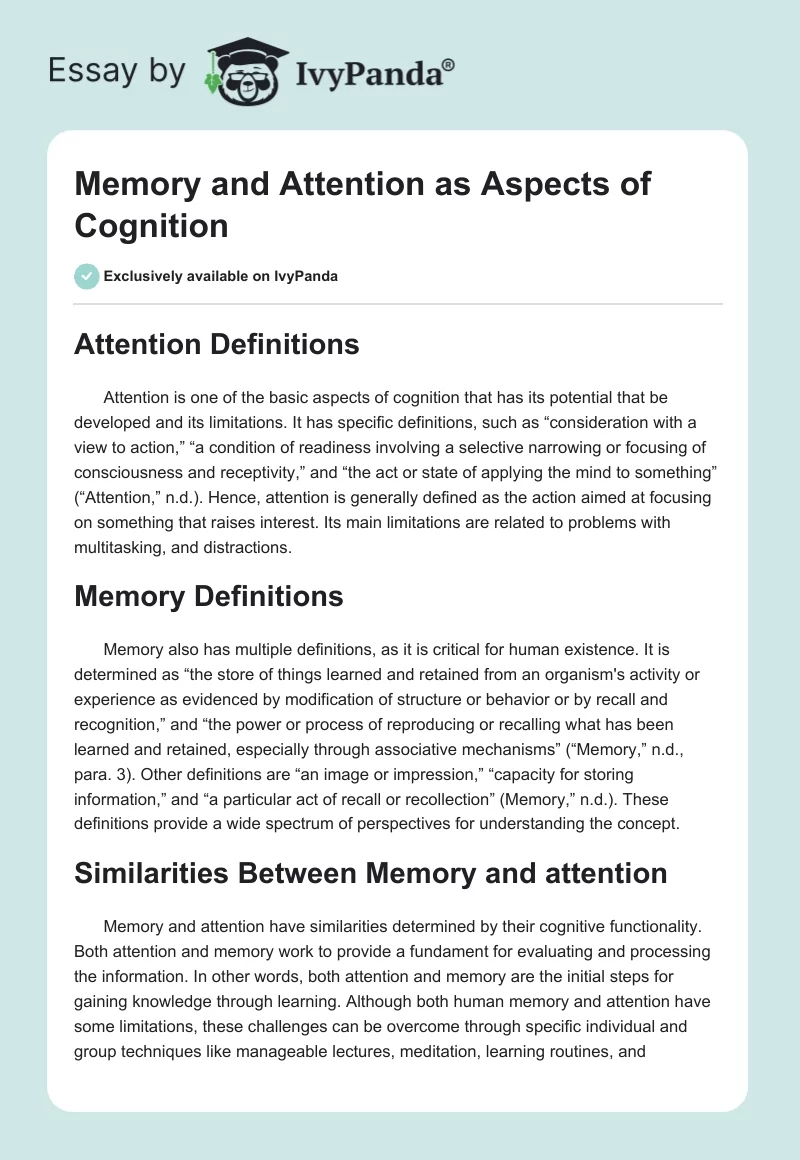Attention Definitions
Attention is one of the basic aspects of cognition that has its potential that be developed and its limitations. It has specific definitions, such as “consideration with a view to action,” “a condition of readiness involving a selective narrowing or focusing of consciousness and receptivity,” and “the act or state of applying the mind to something” (“Attention,” n.d.). Hence, attention is generally defined as the action aimed at focusing on something that raises interest. Its main limitations are related to problems with multitasking, and distractions.
Memory Definitions
Memory also has multiple definitions, as it is critical for human existence. It is determined as “the store of things learned and retained from an organism’s activity or experience as evidenced by modification of structure or behavior or by recall and recognition,” and “the power or process of reproducing or recalling what has been learned and retained, especially through associative mechanisms” (“Memory,” n.d., para. 3). Other definitions are “an image or impression,” “capacity for storing information,” and “a particular act of recall or recollection” (Memory,” n.d.). These definitions provide a wide spectrum of perspectives for understanding the concept.
Similarities Between Memory and attention
Memory and attention have similarities determined by their cognitive functionality. Both attention and memory work to provide a fundament for evaluating and processing the information. In other words, both attention and memory are the initial steps for gaining knowledge through learning. Although both human memory and attention have some limitations, these challenges can be overcome through specific individual and group techniques like manageable lectures, meditation, learning routines, and eliminating distractions (“Attention in the classroom,” 2019). Hence, teachers can stimulate and improve these aspects of cognition.
Differences Between Memory and Attention
How Memory Works
Memory and attention are different in how they work in the human body. The children obtain memory in several steps: first – by distinguishing new and known objects, second – by determining whether new objects are worth of interest. The third step – is the brain’s deciding if the information is worth retaining to be retrieved in the future. Human memory is not located in the specific brain area, rather it functions across the brain, through the connections between the brain synapses (“Memory: definition, functioning”, 2022). There are five types of memory systems: working or short-term, procedural, perceptual, episodic, and semantic.
How Attention Works
Attention has specific ways of functioning in the human body. First, before paying attention, the human brain selects what is the necessary information. If the information is highly relevant, a person can overcome multiple distractions, and if it is irrelevant or presented in unified blocks, the focusing potential will be very low. The unnecessary information and distractions are filtered, and at some point, this begins being done automatically, without much effort. Attention also functions as an ability to switch from one source of information to another (“Attention in the classroom,” 2019). The interest stimulates the attention choices and can be enhanced by specific techniques (mentioning a person’s name, bright images, loud voices, positioning the source closer, speaking in quiet voices, speaking emotionally or pathetically).
Limitations for Attention and Memory Capacities
There are limitations and challenges to attention and memory capacities. One important problem – is that people are poor at multitasking or dividing their attention between several sources. This limitation may create ‘bottlenecks’ of unprocessed information that was seen as irrelevant or unworthy. Distractions are another important problem that can be overcome through learning routines, discipline, and concentration techniques. Attention has also a problem with maintaining focus for longer periods. Working memory limitations are related to the ability to retain information when it is processed but not stored as worthy of retrieving in the future.
Specific Skills and Teacher Competencies
Specific skills gained through studying the topic of attention and memory as cognitive aspects of learners’ development include the capacity to organize the lessons in a way to overcome attention and memory limitations. These skills go well along with the teacher’s competencies for the remote or hybrid teaching that became inevitable during the pandemic. These are competencies of teaching online, engaging families, meeting the needs of students with disabilities, meeting the needs of English Language Learners and Multilingual Learners, providing culturally responsive education, and integrating Social Emotional Learning (SEL) (“Professional learning resources,” 2022).
Making evidence-based decisions means adjusting the practice according to the required competencies and scholarly findings. For example, the teachers introduce learning routines like expelling mobile phones, sitting straight, taking turns when answering, and asking questions to overcome attention imitations. Teachers can also introduce contemplative practices like yoga, and mindfulness, and encourage healthy diets and adequate sleeping. The educators should make the lectures maximally perceptive, which can be done by breaking information into smaller manageable blocks. The information in the lectures can be interleaved as it stimulates attention (“Attention in the classroom,” 2019).
References
Attention (n.d.). Merriam Webster Dictionary. Web.
Attention in the classroom (2019). The Emotional Learner. Web.
Bergin, C. C., & Bergin, D. A. (2019). Child and Adolescent Development in Your Classroom, Chronological Approach. Cengage Learning.
Memory (n.d.). Merriam Webster Dictionary. Web.
Memory: definition, functioning (2022). For Care Education and Research. Web.
Professional learning resources (2022). New York State Education Department. Web.
Young, R. E., Goldberg, J. O., Struthers, C. W., McCann, D., & Phills, C. E. (2019). The subtle side of stigma: Understanding and reducing mental illness stigma from a contemporary prejudice perspective. Journal of Social Issues, 75(3), 943-971.


